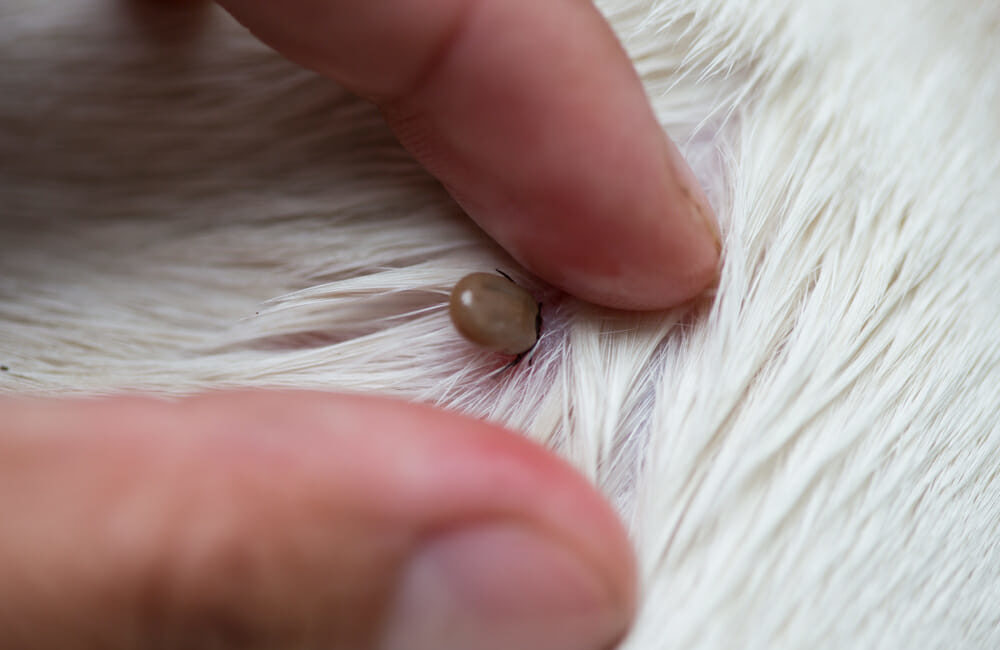Ticks are all the rage this season, with many reports saying ticks are coming back with a bang. In previous years, about 50% of Nova Scotia was at high risk for Lyme disease; this year’s estimate is 95%. What’s important to know?
The biggest issue for most people when they hear “tick” is Lyme disease. There is only one known Lyme carrying tick as of right now in Nova Scotia — the Ixodes Scapularis, or better known as the black-legged deer tick. Lyme is an issue for everyone, those on four legs and those on two. Lyme disease can be transmitted to both humans and pets. Early detection can help with treatment. When you find a tick on your pet, you should always let your veterinarian know. Even if you took it off yourself, tell your veterinarian so they can conduct a 4DX snap test to check for Lyme disease. With proper medication, pets can make a full recovery. Unfortunately for people, we are not so lucky and are often left with permanent consequences such as paralysis. It’s very important to do a tick check after ANY outing, whether it’s on the sidewalks in the city or in the woods. We have also confirmed Lyme disease cases from pets whose owners have never taken them into the woods.
When checking yourself for ticks, check all the hidden warm places as those are the favourite spots for ticks to hide such as the inner thigh, back, ankles, neck and armpits. People don’t have a line of defence like our pets do, so early detection is key. Easy ways to avoid ticks is using tick repellent with DEET, and wearing clothes (long pants and socks) that cover skin.
When checking your furry friend for ticks, check in their groin area, under the legs, between their toes, around their neck, and their ears. These are some favourite spots for ticks to hide. The easiest way to avoid ticks is to have proper tick and flea prevention like Bravecto or Nexgard. Ask your veterinarian if you have any questions about ticks, tick repellant, or tick prevention medication!
Unfortunately, Lyme disease isn’t the only thing ticks like to share, and the black-legged deer tick isn’t the only one who shares. Anaplasmosis is becoming much more common in Nova Scotia. Anaplasmosis can cause respiratory failure and organ failure in people if left untreated for too long. In pets, anaplasmosis causes similar symptoms to Lyme disease, and it isn’t uncommon to have both. Some signs and symptoms include lameness, nausea, and lethargy. It’s also common to show no signs or symptoms until it’s too late which is why tick checks are so important. Anaplasmosis is carried by the black-legged deer tick. Another tick-borne disease is ehrlichiosis carried by the brown dog tick, also found in Nova Scotia. Symptoms of ehrlichiosis include fever, respiratory distress, bleeding issues, swollen limbs, and eye issues.
Ticks are no joking matter as they don’t take preference to their host. Some can even complete their life cycle without a host and keep infesting your life. Both cats and dogs are at risk, and although cats get tick-borne illnesses less often than dogs, it is still completely possible. Ticks don’t respect your front door as a barrier. You can bring ticks into your home which can then find a blood meal on your pets. Flea and tick prevention is available for your cats and dogs so don’t hesitate to ask your veterinarian.
It’s important to remove ticks as soon as you find them, either on you or your pet. They can be removed the same way. Tick twisters may be available at your veterinarian, but are also available at any outdoor store, and they’re very simple to use. Never use alcohol, fire, vaseline, or any other method to make the tick “back out” of their hold, as this often causes them to vomit while still engorged and that can transfer their toxins.
Ticks travel on their hosts and migratory birds are the most common mode of transport. Because of this and our changing climate, birds are moving to different places all the time. New ticks are making their way to Nova Scotia regularly and diseases are becoming more prevalent. It’s important to stay up to date on what’s happening with ticks in your area and protect your pet accordingly. Stay informed and remember — ticks don’t only hide in the woods.
Written by: Chelsea Dicks, CCS



